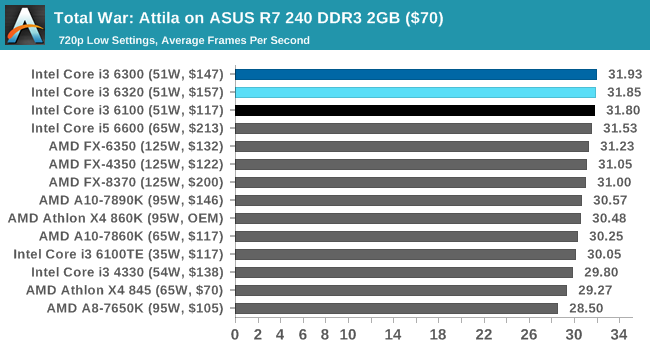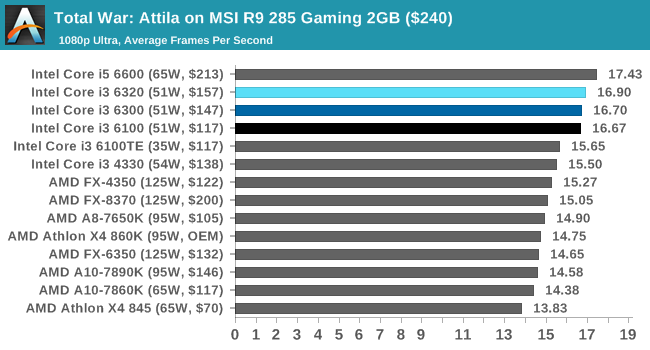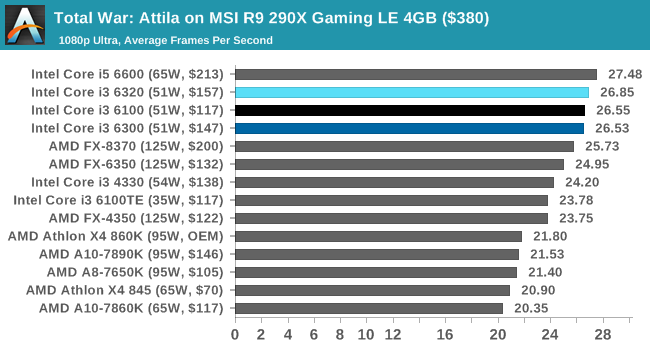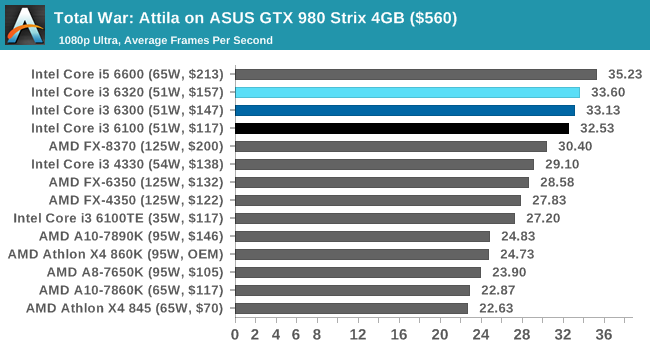The Skylake Core i3 (51W) CPU Review: i3-6320, i3-6300 and i3-6100 Tested
by Ian Cutress on August 8, 2016 9:00 AM ESTTotal War: Attila
The Total War franchise moves on to Attila, another The Creative Assembly development, and is a stand-alone strategy title set in 395AD where the main story line lets the gamer take control of the leader of the Huns in order to conquer parts of the world. Graphically the game can render hundreds/thousands of units on screen at once, all with their individual actions and can put some of the big cards to task. In our benchmark, the in-game scripted benchmark is used with the option for ‘unlimited video memory’ enabled.
For this test we used the following settings with our graphics cards:
| Total War: Attila Settings | |||
| Resolution | Quality | ||
| Low GPU | Integrated Graphics | 1280x720 | Performance |
| ASUS R7 240 1GB DDR3 | |||
| Medium GPU | MSI GTX 770 Lightning 2GB | 1920x1080 | Quality |
| MSI R9 285 Gaming 2G | |||
| High GPU | ASUS GTX 980 Strix 4GB | 1920x1080 | Quality |
| MSI R9 290X Gaming 4G | |||

For the integrated graphics, despite the difference between the APUs and Core parts, we can see the effect of 10% GPU frequency and a smaller L3 cache has on the i3-6100 (which has 3MB). The i3-6100TE is an oddball of the group, by actually having 4MB of L3 cache, which nudges it ahead of the regular i3-6100 by a small amout. Either way, the Intel GPUs aren't great for Attila gaming at 720p Low.





With the discrete graphics cards, the Core i3s again sit at the top or near the top in a regular staircase. Attila still seems to be a bit of a hog for frame rates at 1080p Ultra, barely scraping 30 FPS average on the GTX 980 with the Core i3 parts.











94 Comments
View All Comments
DonMiguel85 - Monday, August 8, 2016 - link
I remember in Eurogamer's i3-6100 review, just using 2666 or 3200MHz DDR4 gave a significant performance boost in pretty much all games, especially Ryse whose maximum FPS almost doubled from 59 to over 100FPS. And this was at the stock CPU clockspeed. Minimum frames improved substantially too.wintermute000 - Monday, August 8, 2016 - link
Problem is the price premium for 3200Mhz, you're already halfway to the cost of a dGPU like a GTX950 or R460 that will blow the doors off any iGPUwintermute000 - Monday, August 8, 2016 - link
whoops I guess I was looking at the expensive stuff, realised that not all 3200 is priced that much higherbeginner99 - Tuesday, August 9, 2016 - link
exactly. If you go Skylake, buy 3200 mhz RAM. For 16 GB it's only $20-30 more than 2133 mhz RAM and totally worth it.fanofanand - Monday, August 8, 2016 - link
Fantastic article Ian, you are definitely doing a great job of filling in the "lull" period between major GPU reviews. I have been wanting exactly this review to be done, as I would love to be able to build my kid a cheap computer for school that could do a bit of light gaming. I was really hoping the APUs would give adequate performance, but it looks like I will be waiting for Zen. I really don't want to get a dGPU for his computer and with Intel it doesn't look like there is much of a choice. Zen it is! Please don't disappoint us AMD!BrokenCrayons - Tuesday, August 9, 2016 - link
I'm keenly interested in seeing what Zen brings to the table too. However my next desktop PC upgrade is going to be a GPU of some sort and even that's probably a good 6+ months away if not more. Zen will be another CPU+Mobo+RAM swap and I'm not looking forward to anything of the sort right now...unless Zen can more than double the performance of my 860K, at which point I'll be very interested.Achaios - Monday, August 8, 2016 - link
Bought a brand new laptop today with an Intel Core i5-6200U Skylake onboard (which you have failed to include in your table) clocked at 2.3 GHz which turbos to 2.8 GHz.The thing I wanna say if you try to install Windows 7 on a Skylake machine without making a little in-depth research, you're screwed.
One way to install Windows 7 on Skylake machines is described by the following ASROCK article:
http://www.asrock.com/microsite/win7install/
(Thank you ASROCK).
I am not ashamed to say I spent the better part of day fighting off the dreaded "A required CD/DVD drive device driver is missing" before I had my Windows 7 Pro 64 Bit slipstreamed and updated by ASROCK's app.
Perhaps you should consider adding a couple of words on the subject as there are many ppl who will stay on Windows 7 for several years to come and are not very familiar with the Skylake platform.
DonMiguel85 - Monday, August 8, 2016 - link
Well, of course it's not on the table - that's a mobile chip. Plus unless you have some specific business need to use Windows 7 I don't see why you would go through the hassle of putting it on there. It's an almost 7 year old OS.fanofanand - Tuesday, August 9, 2016 - link
LOL "failed to include" I love it. "I bought it so you should review it, even if it's not even in the same segment as the other products you are reviewing". Classic snowflake narcissism.Meteor2 - Tuesday, August 9, 2016 - link
1. I wish you'd calculated price/performance and power/performance for us, rather than leaving us to guesstimate2. The game benchmarks need 95th (or whatever) percentile frame rates and minimum frame times, as that's where the performance difference between i3 and i5 truly lies.